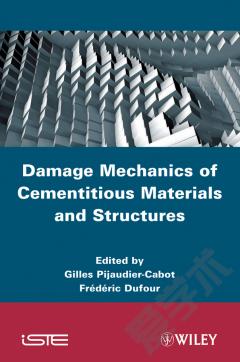Fracture Mechanics of Cementitious Materials
Chapter One: Introduction. Chapter Two: Fundamentals of fracture mechanics. Introduction Griffith's theory of fracture The compliance method of calculating the elastic potential energy release rate Energetic stability Linear elastic fracture mechanics (LEFM) Crack opening displacement The t-stress and higher order stress terms Crack growth resistance Non linear fracture mechanics (NLFM) Summary of the application of classic fracture mechanics to cementitious materials. Chapter Three: Fracture mechanisms in cementitious materials. Introduction Cementitious materials Cementitous fibre reinforced composites Fracture mechanisms in cementitious materials and fibre composites Summary. Chapter Four: Fracture parameters for cementitious materials. Introduction Experimental techniques for measurement of the FP2 and FB2 Measurement of mode1 stain-softening relationship for cementitous materials Modelling the mode1 strain-softening relationship for cenentitious materials Measurement of mode1 fracture engery Modelling the mixed mode strain softening relationship for cementitious materials Experimental techniques for the measurement of FP2 and FB2 in firbe reinforced cementitious materials Measurement of the mode1 strain-softening relationship for fibre reinforced cementitious materials The stress strain relationship for fibre reinforced cementitious materials The toughness of fibre reinforced composites Summary. Chapter Five: Theoretical models for fracture in fibre reinforced cementitious materials. Introduction The flexure of stain-softening materials Equivalent crack models The crack band model The ficticious crack model Size and notch effects Asymmetrical fracture Summary. Chapter Six: Theoretical models for fracture in fibre-reinforced cementitious materials. Introduction Engineers' theory of bending analysis of type II composites Fracture behaviour of short fibre type II reinforced cementitious composites Crack growth models for fibre-reinforced cementitious composites Crack growth models for fibre-reinforced type II cementitious composites Size effect and the R-curve Summary. Chapter Seven: The statistical nature of fracture in cementitious materials. Introduction The strength distribution for ideal brittle solids The statistics of heterogeneous brittle materials Statistics and size effects in cementitious materials Statistics of fibre reinforced cementitious materials Summary. Chapter Eight: Time- dependent fracture behaviour of cementitious materials. Introduction Modelling time-dependent crack growth in brittle materials Summary. Chapter Nine: Application of fracture mechanics to the design of structures. Introduction Application to montlithic structures Punching shear failure of slabs reinforcement bonding and anchorage to concrete Concreate pipes Summary. References. Nomenclature. Index.
{{comment.content}}








 京公网安备 11010802027623号
京公网安备 11010802027623号